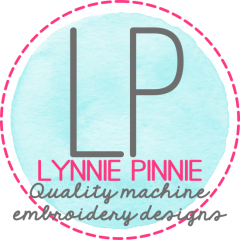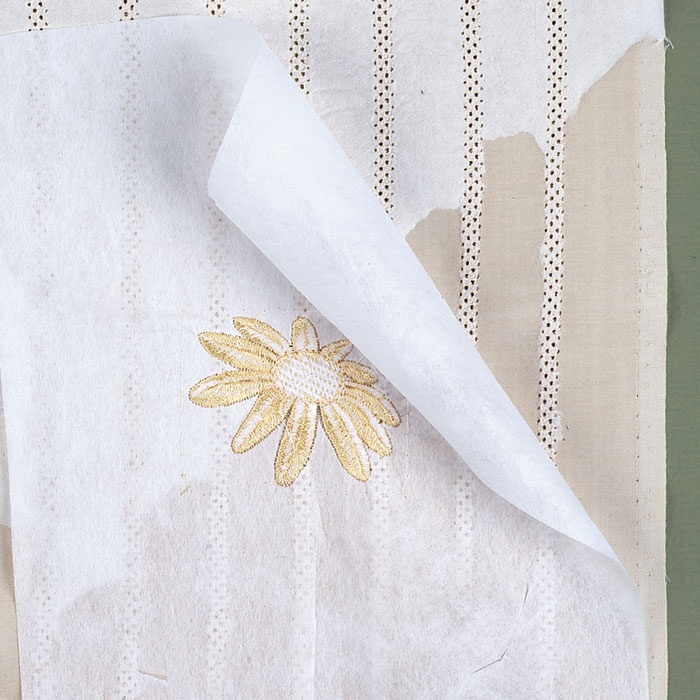As a singing nun in Austria once advised, the best place to start is at the very beginning, so the first thing we’ll discuss is the basic categories of stabilizer. As with most things, the basics can quickly get a little complicated, as each basic category can split into subcategories that contain stabilizers with more specific uses. In order to make this as easy to understand as possible, think of it like building blocks. You learn the basic categories, which are your foundation, and then move on the the more specific options, often called specialty stabilizers or backings, which might have a less broad application or may even be applied only to one specific type of job.
At the most basic level, there are essentially two categories of stabilizer, cutaway and tearaway. As the names imply, tearaway stabilizer can be torn, while cutaway requires removal with scissors. Pretty much every type of stabilizer falls into one of these two categories. The exception to this rule would be water soluble, which requires water to be removed. Water solubles are a popular option for patches or free standing lace and also tend to be toppings. A topping is a stabilizer that is used to keep stitches from sinking into pile fabrics. It is a useful option for those embroidering towels or fleece.
For many embroiderers, tearaway seems like the optimal stabilizer solution, mostly because removal can often happen fairly quickly, since the excess stabilizer can easily be torn away. A quality tearaway, one that is well made, will tear quickly and cleanly. A tearaway stabilizer that is of lesser quality or less well made, won’t tear cleanly and often will leave fuzzy edges that can fray or make the embroidery look untidy. A quality tearaway will also stabilize effectively and hold stitches firmly, but only require a minimum amount of force to tear. A tearaway that requires yanking hard to remove excess stabilizer runs the risk of pulling stitches and distortion of the finished product.
Tearaway stabilizers generally come in three options: light weight (1.5 or 1.8 ounce), medium weight (2.0 or 2.5 ounce) and heavy weight (3.0 ounce). In some cases, the medium and heavy weight options may also be called “hat” or “cap” backing. The name comes from the fact that these weights will most often be used when embroidering a hat. The stabilizers known as cap backings are heavier weight, usually stiffer and more paper-like, which means they can stabilize heavy fabrics and tear sharply and quickly.
Cutaway stabilizers, as the name implies, will require a little more work to remove. All cutaway stabilizers will require cutting away the excess stabilizer as the method of removal. Some embroiderers prefer to cut close to the stitches while others will cut as far away as possible from the stitched design. A common trick is to cut the stabilizer to slightly larger than the design, which lessens the need for cutting after the embroidery is completed.
Cutaway stabilizer is a popular option for use with lighter or stretchy fabrics as it provides the fabric with increased stability. Embroidery on heavy weight fabrics like sweatshirt material, or jackets, can also work well with a cutaway stabilizer. While there are light weight cutaways available, a 2.5 ounce cutaway is considered by some to be the universal stabilizer option. A 3.0 cutaway may be the weight used when embroidering heavier fabrics, but 2.5 ounce cutaway is, for some, the only stabilizer they ever use.
The third category of stabilizer is the water soluble options, which are stabilizer, but aren’t generally designed to remain with the fabric for the long term. As the name implies, a water soluble stabilizer dissolves when water is applied to it. Only the parts that have been actually embroidered remain to do their job. Water soluble stabilizer can be a cutaway/washaway, which looks somewhat like a standard stabilizer but which dissolves in water, or it can look more like plastic. The versions that appear to be more like plastic will either be Vilene or Badgemaster, which are heavier water soluble stabilizers that are often used for badges and sometimes used for free standing lace. The other water soluble option, which has the appearance of a thin plastic, is a water soluble topping, which is used to keep stitches from sinking into towels or fleece. You may often here water soluble toppings referred to as Solvy, but that is an inaccurate description. Solvy is a trademarked name for water soluble toppings from Sulky, but has, over the years, become a more generic term, like Kleenex when used for tissue regardless of actual brand name.
Author’s note: This is the first chapter of a book about stabilizer that is in process currently. We hope to have it available for sale soon.


Thanks so much. This has been the most confusing thing for me as I try to learn machine embroidery. I would love to have the book when it is completed.